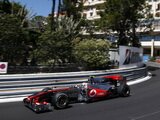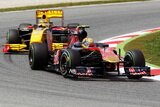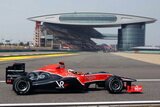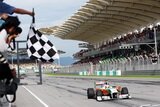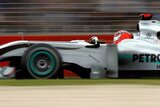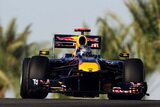Changes for next season - expected to save teams at least 30 percent on their 2008 budgets - include a ban on in-season testing, limiting each driver to eight engines - effectively doubling engine life - and cuts in aerodynamic research.
Cost of engines to independent teams will be halved for 2009 and drivers must use the same engine for three consecutive races, with maximum revs cut from 19,000 to 18,000 rpm.
Following moves to equalise engine performance for next season, Renault have been granted permission to make certain modifications to their V8. All other team's engines will remain unchanged.
From 2010 all teams will be able to obtain engines for less than €5 million per season, either from an existing manufacturer or from an independent supplier, and all teams are likely to use the same transmission. Refuelling and tyre warmers will be banned.
The possibility of an entirely new, more energy-efficient and road-relevant power train, likely to include an enhanced KERS system, will be investigated for 2013.
Details of further changes for 2009 and 2010 are due to be announced shortly.
The full statement from the FIA:
The World Motor Sport Council met in Monaco on 12 December 2008. The following decisions were taken:
FORMULA ONE WORLD CHAMPIONSHIP
The following measures to reduce costs in Formula One have been agreed by the World Motor Sport Council. These proposed changes have the unanimous agreement of the Formula One teams, who have played a major role in their development. The FIA is grateful to the Formula One Teams Association (FOTA) and its Chairman Luca di Montezemolo for their incisive contribution.
2009
Engine
• Engine life to be doubled. Each driver will use a maximum of eight engines for the season plus four for testing (thus 20 per team).
• Limit of 18,000 rpm.
• No internal re-tuning. Adjustment to trumpets and injectors only.
• The three-race rule voted on 5 November remains in force.
• Cost of engines to independent teams will be approximately 50% of 2008 prices.
• Unanimous agreement was reached on a list of proposed changes to the Renault engine for 2009; all other engines will remain unchanged. Comparative testing will not be necessary.
Testing
• No in-season testing except during race weekend during scheduled practice.
Aerodynamic research
• No wind tunnel exceeding 60% scale and 50 metres/sec to be used after 1 January 2009.
• A formula to balance wind tunnel-based research against CFD research, if agreed between the teams, will be proposed to the FIA.
Factory activity
• Factory closures for six weeks per year, to accord with local laws.
Race weekend
• Manpower to be reduced by means of a number of measures, including sharing information on tyres and fuel to eliminate the need for “spotters”.
Sporting spectacle
• Market research is being conducted to gauge the public reaction to a number of new ideas, including possible changes to qualifying and a proposal for the substitution of medals for points for the drivers. Proposals will be submitted to the FIA when the results of the market research are known.
Note: It is estimated that these changes for 2009 will save the manufacturer teams approximately 30% of their budgets compared to 2008, while the savings for independent teams will be even greater.
2010
Power train
• Engines will be available to the independent teams for less than €5 million per team per season. These will either come from an independent supplier or be supplied by the manufacturer teams backed by guarantees of continuity. If an independent supplier, the deal will be signed no later than 20 December 2008.
• This same engine will continue to be used in 2011 and 2012 (thus no new engine for 2011).
• Subject to confirmation of practicability, the same transmission will be used by all teams.
Chassis
• A list of all elements of the chassis will be prepared and a decision taken in respect of each element as to whether or not it will remain a performance differentiator (competitive element).
• Some elements which remain performance differentiators will be homologated for the season.
• Some elements will remain performance differentiators, but use inexpensive materials.
• Elements which are not performance differentiators will be prescriptive and be obtained or manufactured in the most economical possible way.
Race weekend
• Standardised radio and telemetry systems.
• Ban on tyre warmers.
• Ban on mechanical purging of tyres.
• Ban on refueling.
• Possible reduction in race distance or duration (proposal to follow market research).
Factory activity
• Further restrictions on aerodynamic research.
• Ban on tyre force rigs (other than vertical force rigs).
• Full analysis of factory facilities with a view to proposing further restrictions on facilities.
Longer term
The FIA and FOTA will study the possibility of an entirely new power train for 2013 based on energy efficiency (obtaining more work from less energy consumed). Rules to be framed so as to ensure that research and development of such a power train would make a real contribution to energy-efficient road transport.
An enhanced Kinetic Energy Recovery System (KERS) system is likely to be a very significant element of an energy-efficient power train in the future. In the short term, KERS is part of the 2009 regulations, but is not compulsory. For 2010 FOTA is considering proposals for a standard KERS system. The FIA awaits proposals.
Comments:


